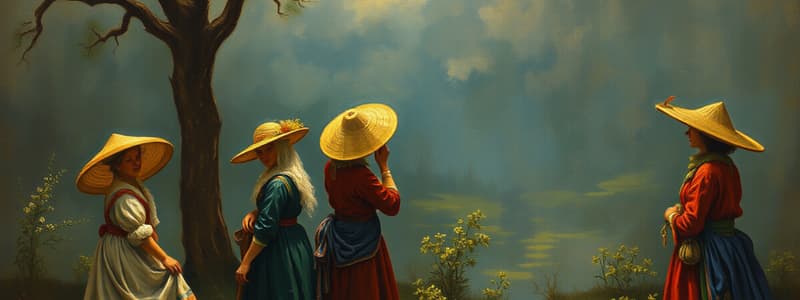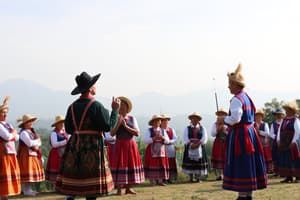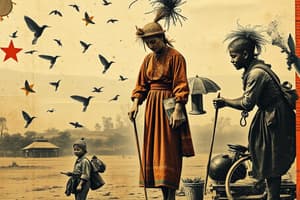Podcast
Questions and Answers
The term folk is primarily associated with modern trends and styles.
The term folk is primarily associated with modern trends and styles.
False (B)
Folk cultures typically originate from transient populations with no geographic ties.
Folk cultures typically originate from transient populations with no geographic ties.
False (B)
Folk culture is transmitted mainly through digital communication rather than personal interaction.
Folk culture is transmitted mainly through digital communication rather than personal interaction.
False (B)
The stability of folk cultures over time is equivalent to their consistency across different geographic spaces.
The stability of folk cultures over time is equivalent to their consistency across different geographic spaces.
Folk customs are known to change rapidly over time.
Folk customs are known to change rapidly over time.
Folk cultures rely on a limited variety of crops for their food needs.
Folk cultures rely on a limited variety of crops for their food needs.
The construction techniques of houses in folk cultures tend to encourage experimentation with different designs.
The construction techniques of houses in folk cultures tend to encourage experimentation with different designs.
Folk cultures diffuse their customs through a process called relocation diffusion.
Folk cultures diffuse their customs through a process called relocation diffusion.
Global culture is perceived as primarily individualistic, secular, and eastern.
Global culture is perceived as primarily individualistic, secular, and eastern.
Movements like Al-Qaeda support the proliferation of popular culture worldwide.
Movements like Al-Qaeda support the proliferation of popular culture worldwide.
Resistance to popular culture can manifest through movements that prioritize local traditions and food sourcing.
Resistance to popular culture can manifest through movements that prioritize local traditions and food sourcing.
William Gibson claimed that the future is uniformly experienced across all regions of the world.
William Gibson claimed that the future is uniformly experienced across all regions of the world.
Folk cultures are typically more short-lived than popular cultures.
Folk cultures are typically more short-lived than popular cultures.
Anti-globalists are generally united in their beliefs and do not have any differing perspectives.
Anti-globalists are generally united in their beliefs and do not have any differing perspectives.
Economic pressures sometimes lead individuals to commercialize religious and cultural practices for tourism.
Economic pressures sometimes lead individuals to commercialize religious and cultural practices for tourism.
Fundamental needs are identical around the globe and do not vary from one region to another.
Fundamental needs are identical around the globe and do not vary from one region to another.
Hierarchical diffusion primarily involves the spread of popular culture from smaller places to larger, well-connected areas.
Hierarchical diffusion primarily involves the spread of popular culture from smaller places to larger, well-connected areas.
The concept of cultural lag refers to the time gap it takes for a new idea or product to reach remote areas.
The concept of cultural lag refers to the time gap it takes for a new idea or product to reach remote areas.
Commodification transforms cultural attributes into mass-market products that retain their original form.
Commodification transforms cultural attributes into mass-market products that retain their original form.
Globalization integrates the world into a single economic unit, leading to friction in the movement of ideas and people.
Globalization integrates the world into a single economic unit, leading to friction in the movement of ideas and people.
Products like Taco Bell and Panda Express are known for their authentic cultural cuisines in their respective countries of origin.
Products like Taco Bell and Panda Express are known for their authentic cultural cuisines in their respective countries of origin.
The integration of global products into local markets is a common marketing strategy used by companies.
The integration of global products into local markets is a common marketing strategy used by companies.
The main motivation for popular culture products is to promote authenticity and preserve cultural heritage.
The main motivation for popular culture products is to promote authenticity and preserve cultural heritage.
With the rise of global culture, national popular culture producers are increasingly merging into international producers.
With the rise of global culture, national popular culture producers are increasingly merging into international producers.
Only a few large companies account for the majority of global music sales.
Only a few large companies account for the majority of global music sales.
Cultural diffusion indicates that popular culture changes slowly and remains stable across time.
Cultural diffusion indicates that popular culture changes slowly and remains stable across time.
The phrase 'The medium is the message' implies that pop culture can market itself effectively.
The phrase 'The medium is the message' implies that pop culture can market itself effectively.
Video games, movies, and entertainment are increasingly designed solely for domestic markets.
Video games, movies, and entertainment are increasingly designed solely for domestic markets.
Folk intoxicants have a minimal modern global cultural impact compared to their traditional purposes.
Folk intoxicants have a minimal modern global cultural impact compared to their traditional purposes.
Cultural attributes change little when they enter the mass-market as commodified products.
Cultural attributes change little when they enter the mass-market as commodified products.
Folk medicinal systems are primarily based on local trees and shrubs.
Folk medicinal systems are primarily based on local trees and shrubs.
The Slow-food movement is driven by a desire to experience elements of popular culture.
The Slow-food movement is driven by a desire to experience elements of popular culture.
Intoxicants have historically been ignored in discussions about culture.
Intoxicants have historically been ignored in discussions about culture.
The concept of Gemeinschaft refers to life in a large society.
The concept of Gemeinschaft refers to life in a large society.
The Internet has accelerated the diffusion of popular culture.
The Internet has accelerated the diffusion of popular culture.
John Lomax is known for his work in recording antique car models.
John Lomax is known for his work in recording antique car models.
Holidays serve as a means to reinforce cultural norms.
Holidays serve as a means to reinforce cultural norms.
Popular culture is primarily characterized by being inexpensive.
Popular culture is primarily characterized by being inexpensive.
Cultural interchange in the United States has roots in the waves of people from folk cultures.
Cultural interchange in the United States has roots in the waves of people from folk cultures.
Psychoactive substances like alcohol and tobacco were unknown in folk cultures.
Psychoactive substances like alcohol and tobacco were unknown in folk cultures.
The diffusion of tomatoes from the Americas to Italy occurred in a matter of weeks.
The diffusion of tomatoes from the Americas to Italy occurred in a matter of weeks.
The primary role of marketing in popular culture is to ensure industries do not go bankrupt.
The primary role of marketing in popular culture is to ensure industries do not go bankrupt.
Popular culture and folk culture are indistinguishable in their influences on daily life.
Popular culture and folk culture are indistinguishable in their influences on daily life.
Fashion relates solely to clothing trends in popular culture.
Fashion relates solely to clothing trends in popular culture.
Acculturation pressures are minimal for people migrating to areas with popular culture.
Acculturation pressures are minimal for people migrating to areas with popular culture.
Flashcards are hidden until you start studying
Study Notes
Folk Culture
- Folk culture evokes traditional costumes, dances, and music, often seen in festivals and museums.
- The term "folk" derives from Old Norse/English/Germanic, originally describing an army or clan, emphasizing shared identity.
- Rooted in specific geographic locations, folk cultures are found in small, homogeneous groups.
- Stable over time but variable across different regions, folk customs evolve slowly, originating in the past.
- Knowledge and cultural practices are transmitted through person-to-person interaction, emphasizing hands-on learning.
- Resource utilization is based on local availability, impacting architecture, culinary practices, and medicinal systems.
- Folk entertainment often reinforces cultural beliefs, with music and folktales serving as essential aspects of community identity.
- Holidays provide communal entertainment and opportunities to challenge social norms, such as Mardi Gras.
- Intoxicants play a role in folk culture, traditionally used in rituals, yet often commercialized in modern contexts.
- The revival of interest in folk culture has been driven by movements like Slow Food and cultural tourism.
- Historical preservation of folk culture is exemplified by figures like the Grimm Brothers and John Lomax, who sought to document fading traditions.
- Handcrafted goods differ significantly from industrial products, highlighting the deep knowledge embedded in folk craftsmanship.
Changing Cultural Landscape
- The decline of folk culture is influenced by the rise of popular culture and changing political landscapes.
- Nationalistic policies have marginalized minority cultures, fostering a uniform national culture through education and language.
- Economic shifts since the Industrial Revolution have led to shrinking rural communities, disrupting the reproduction of folk cultures.
- Migration to urban areas practicing popular culture intensifies pressures to assimilate, compromising folk traditions.
- Enhanced infrastructure and technology, such as the Internet, accelerates the diffusion of popular culture, widening cultural exchange.
- The U.S. serves as a cultural melting pot, with diverse folk cultures influencing the broader culture due to immigration.
Popular Culture
- Popular culture primarily focuses on commercial consumption, impacting local production of food, clothing, and housing.
- Driven by marketing, industries continually reinvent trends to ensure products remain appealing to consumers.
- Fashion influences various markets beyond clothing, affecting automobiles, fast food, and holiday commercialization, particularly in Western contexts.
- Hierarchical diffusion sees new cultural trends originating in major cities, later reaching smaller communities, leading to cultural lag.
- Popular culture is characterized as stable over geographic space but variable over time due to constant marketing changes.
- Commodification alters folk customs, exemplified by global fast-food chains serving modified cultural products.
- International corporations dominate cultural content, accounting for a significant share of global sales in music and entertainment.
Interface Between Local and Global
- Globalization intertwines local and global cultures, with commerce driving product survival in the marketplace.
- Commodification transforms cultural attributes into mass-market products that may differ substantially from their origins.
- Global brands often adapt their offerings to local needs while prioritizing profit over authenticity, reshaping cultural landscapes.
Global Culture
- Globalization creates a homogeneous global culture, blurring local distinctions and integrating diverse cultural elements.
- Media products, such as video games and movies, aim for international appeal, facilitating the merging of national popular cultures.
- Transnational corporations dominate cultural distribution channels, significantly influencing local practices and consumer preferences.
- Disparities in access to technology showcase the uneven distribution of globalization's benefits.
Resistance to Popular Culture
- Growing opposition to popular culture manifests from concerns over corporate influence, secularization, and loss of regional identity.
- Resistance is expressed through movements advocating for local customs, such as farm-to-table initiatives and the Slow Food movement.
- Anti-globalist sentiments emerge from both political spectrums, emphasizing the need to preserve local autonomy and cultural heritage.
- Nostalgic views of a "golden age" can drive backlash against perceived cultural erosion by modern popular influences.
- Cultivating locally sourced food challenges the dominance of global fast-food entities, highlighting a broader movement towards cultural preservation.
Studying That Suits You
Use AI to generate personalized quizzes and flashcards to suit your learning preferences.




